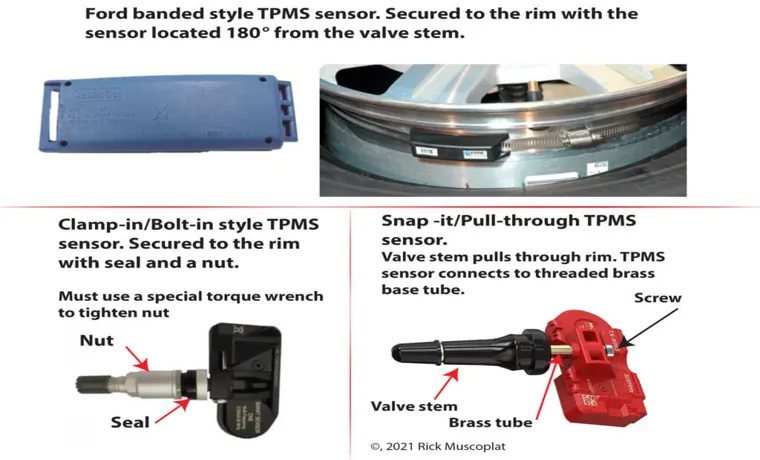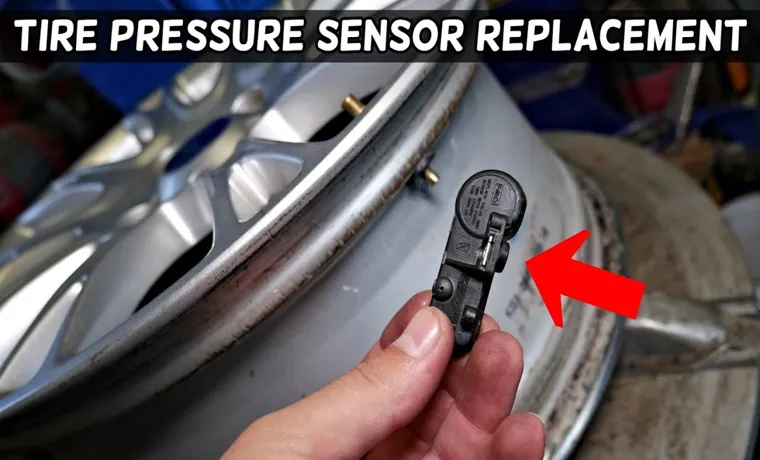Have you ever wondered where the tire pressure sensor goes? It’s a common question many drivers have asked themselves, especially when they encounter issues with their vehicle’s TPMS (Tire Pressure Monitoring System). The good news is that the answer is not complicated. In fact, the location of the TPMS sensor is quite straightforward and can be easily identified.
In this blog post, we will explore the ins and outs of the TPMS sensor, where it is located on your car, and why it plays such a vital role in maintaining your vehicle’s overall safety.
Overview of tire pressure sensors
When it comes to tire pressure sensors, many drivers wonder where they are located on their vehicle. Typically, these sensors are placed inside the tire valve stem or attached to the rim of the wheel. Some vehicles may also have sensors integrated into the hub assembly or within the tire itself.
It’s important to note that not all vehicles have tire pressure sensors, as they became mandatory in all cars in 200 These sensors monitor the air pressure in your tires and will alert you if the pressure becomes too low or high. This can help improve your safety on the road, as well as your fuel efficiency and tire wear.
If you’re unsure whether or not your vehicle has tire pressure sensors or where they are located, consult your owner’s manual for more information.
How tire pressure sensors work
Tire pressure sensors are an essential safety feature in modern vehicles. These sensors work by monitoring the air pressure in each tire and transmitting that information to a central processor, which then alerts the driver if there is an issue. The sensors themselves are typically small, battery-powered devices that are mounted inside the tire and are able to detect changes in pressure that could be caused by a leak or other issue.
When a tire’s pressure falls below a certain level, the sensor sends an alert to the car’s onboard computer, which in turn signals the driver to stop and check the tire. This system helps drivers avoid dangerous blowouts and ensures that their tires remain properly inflated, which can improve fuel efficiency and prolong tire life. Overall, tire pressure sensors are an important safety feature that help keep drivers and passengers safe on the road.

Types of tire pressure sensors
Tire pressure sensors are crucial for maintaining safety on the road and ensuring optimal vehicle performance. There are several types of tire pressure sensors, including direct and indirect sensors. Direct sensors are located inside the tire and measure the actual pressure, while indirect sensors use wheel speed sensors to calculate tire pressure based on the rotation of the tire.
Some vehicles also come equipped with temperature sensors to help regulate the pressure in the tire. It’s important to note that these sensors require maintenance, such as battery replacements, and may fail over time, so it’s essential to regularly check tire pressure manually as well. Overall, tire pressure sensors play a critical role in keeping drivers and passengers safe on the road.
Location of tire pressure sensors
If you’re wondering where the tire pressure sensor goes, the answer is pretty straightforward. It’s usually located inside the tire itself. This small device is responsible for measuring the tire’s pressure and sending that information to the car’s computer system.
The tire pressure sensor has become more common in recent years as safety regulations require cars to have a tire pressure monitoring system (TPMS). The sensor is installed during the tire mounting process, and it typically lasts for many years before needing replacement. If you’re experiencing issues with your TPMS, such as a warning light appearing on your dashboard, it’s worth visiting a mechanic to have the system checked.
They can determine if the sensor needs replacing or if there’s another issue that needs addressing. Overall, the TPMS is an important safety feature that helps drivers stay aware of their tire pressure and avoid potential accidents caused by underinflated tires.
Factory installed sensors
When it comes to factory-installed sensors, tire pressure sensors are becoming increasingly common in modern vehicles. These sensors are typically located inside the valve stem of each tire, measuring the pressure and transmitting that data to the vehicle’s computer system. The benefit of this system is that it allows the driver to easily monitor tire pressure in real-time, ensuring optimal performance, fuel efficiency, and safety on the road.
But why are these sensors located inside the valve stem? Well, for one, it’s a convenient and unobtrusive location that doesn’t interfere with the overall design of the wheel. Additionally, the valve stem provides a direct path to the tire, allowing for accurate pressure readings. And thanks to their small size, these sensors can be easily integrated into the valve stem without adding significant weight or changing the balance of the wheel.
Of course, different makes and models of vehicles may have slightly different sensor locations, depending on the design of the valve stem and tire. However, in general, you can expect to find tire pressure sensors nestled inside the valve stems of your tires. And with regular monitoring and maintenance, you can ensure that these sensors continue to provide accurate data and help keep you safe on the road.
Aftermarket sensors
If you’re considering upgrading your vehicle with aftermarket tire pressure sensors, it’s essential to know where to install them. The location of the tire pressure sensors is critical to ensuring accurate readings and efficient tire monitoring. Typically, OE tire pressure sensors are installed as part of the valve stem assembly or integrated into the wheel hub assembly.
However, the location may vary depending on the vehicle make and model. When installing aftermarket sensors, it’s best to consult the manufacturer’s instructions for proper placement. The wrong placement can lead to inaccurate readings and potentially cause issues down the line.
So, take the time to research the ideal location and placement for your aftermarket tire pressure sensors to ensure optimal performance and tire safety.
Placement on the wheels
When it comes to tire pressure monitoring systems, the location of tire pressure sensors is crucial. These sensors are responsible for detecting changes in tire pressure and sending signals to the car’s computer to alert the driver of any potential issues. Generally, the sensors are placed inside the wheels where they can accurately measure the pressure of each tire.
Some cars have sensors directly mounted on the tire’s valve stem while others use sensors that are located inside the tire itself. Regardless of the location, it’s essential that these sensors are properly maintained to ensure accurate readings. Poorly maintained sensors can lead to false readings and potential hazards on the road.
So, it’s important to regularly check the tire pressure sensors and ensure they are functioning correctly. If you’re unsure about the location of your tire pressure sensors, consult your car manual or speak with a mechanic to help you locate them.
Replacing tire pressure sensors
If you’re wondering where the tire pressure sensor goes, it’s usually located inside the tire, attached to the valve stem. This tiny device is responsible for measuring the pressure of the tire and sending the information to the car’s computer through a wireless signal. Over time, these sensors can fail or malfunction, resulting in inaccurate readings or even warning lights on the dashboard.
If you need to replace a tire pressure sensor, it’s important to take your vehicle to a certified mechanic or tire shop. They will remove the tire from the rim and replace the old sensor with a new one, ensuring that it’s properly calibrated and synced with your car’s computer system. It’s not a difficult process, but it does require special equipment and expertise, so it’s best to leave it to the professionals.
Signs of a malfunctioning sensor
If you’re wondering how to tell when your tire pressure sensor isn’t functioning correctly, there are a few signs to look out for. One indicator may be that your dashboard warning light for low tire pressure consistently stays on, even after you’ve inflated your tires to the recommended PSI. Another red flag could be if you notice that one tire always seems lower than the others, or if your tire pressure fluctuates frequently and occasionally even drops to zero.
These can all indicate that your sensor may be malfunctioning and needs to be repaired or replaced. The process of replacing tire pressure sensors can be done by a mechanic or at a tire shop. It involves removing the old sensor, replacing it with a new one, and programming it to work with your vehicle.
Overall, staying on top of tire pressure sensor maintenance can help you avoid potential safety issues and can save you money in the long run by catching problems early on.
When to replace sensors
When it comes to replacing tire pressure sensors, there are a few things to consider. Generally, these sensors have a lifespan of around five to ten years. It’s essential to keep an eye on the battery life of the sensors, as low battery levels can cause inaccurate readings.
Additionally, if you notice that your tire pressure monitoring system (TPMS) light is consistently on, it may be an indication that one or more sensors need replacing. It’s also worth noting that if you’ve recently had new tires fitted, it’s a good idea to have your sensors checked, as they can become damaged during the fitting process. Regular maintenance and checks can help ensure that your TPMS is functioning correctly, providing accurate readings and keeping you safe on the road.
Remember, it’s better to replace a sensor than risk driving with inaccurate tire pressure readings, which could lead to potentially dangerous situations.
Conclusion
In the great wheel of life, the tire pressure sensor is the unsung hero. It may not be glamorous, but it plays a crucial role in keeping us safe and ensuring our wheels roll smoothly. Where does it go, you ask? Well, it finds a cozy spot inside your tire, snugly nestled among the rubber and wires.
And while it may not get the praise it deserves, we can rest easy knowing that our trusty tire pressure sensor is always looking out for us, no matter where we go.”
FAQs
What is a tire pressure sensor?
A tire pressure sensor is a device that measures the air pressure inside your tires and sends that information to your car’s on-board computer.
Why do I need a tire pressure sensor?
A tire pressure sensor helps you maintain proper tire pressure, which can improve fuel economy, prolong tire life, and ensure better handling and safety on the road.
How does a tire pressure sensor work?
The tire pressure sensor uses a small sensor inside the tire to measure the air pressure. It then sends that information wirelessly to your car’s computer, which can alert you if the pressure is too low.
Where is the tire pressure sensor located?
The tire pressure sensor is usually located inside the tire, mounted to the rim. In some cars, it may also be located on the valve stem.
Can I replace a tire pressure sensor myself?
While it is possible to replace a tire pressure sensor yourself, it’s often recommended to have it done by a professional to ensure proper installation and calibration.
What happens if the tire pressure sensor fails?
If the tire pressure sensor fails, your car’s computer may not receive accurate information about tire pressure, which can lead to incorrect readings and potential safety issues.
How often do tire pressure sensors need to be replaced?
Tire pressure sensors can last anywhere from 5-10 years, depending on the make and model of your car. It’s a good idea to have them checked regularly and replaced as needed.

